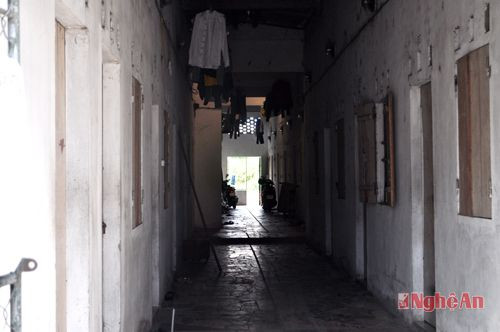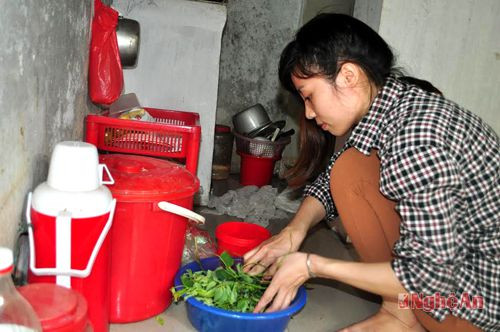Housing for workers: How long to wait?
(Baonghean) - Currently, there are more than 13,000 workers working in industrial parks (IPs) in the province. However, due to the lack of appropriate investment attraction policies and mandatory sanctions, most workers are having to rent houses with inadequate living conditions.
Sloppy, cramped...
At 5 p.m., Dang Thai Mai Street running through Bac Vinh Industrial Park was packed with people. From the factory gates, groups of workers rushed out, stopping busily at street stalls and markets to buy food, then dispersed to the boarding houses. Ms. Nguyen Thi Mui, a worker at Matrix Company, stopped at the temporary market by the roadside to buy a bunch of water spinach, an egg and a few mangoes, then hurried back to her nearby boarding house. We followed Mui, a 19-year-old girl from Nghia Lam (Nghia Dan) to the boarding house in Dong Hung hamlet, Hung Dong commune (Vinh city). The boarding house has about 20 rooms, each 10 square meters wide, with a cement roof. In the hot summer sun, the room became stuffy. Mui's room had no TV, no bed, only a small fan. Mui said that it was hot and cramped, so she asked someone to remove the bed and clean the floor of the room to sleep cooler. “After finishing high school, I went to Vinh to work as a factory worker to earn more income to ease the burden on my parents. Sewing teddy bears is not a hard job, suitable for women, but the salary is low. If we don’t work overtime, we can only earn 3 million VND/month. After work at the factory, we go back to our boarding house to cook and sleep. There is no TV, no sports, luckily we have a phone so we can listen to music to relieve boredom,” Mui shared.
 |
| Row of boarding houses in Nghi Xa commune (Nghi Loc) (large photo). |
Next to Mui's room is the room of Mr. Tran Van Quang, a taxi driver, and Ms. Dau Thi Hang, a worker at Minh Anh Garment Company. The room is less than 10 square meters but is home to 4 people, in addition to Ms. Hang and her husband, there is also a young daughter and Mr. Quang's mother from Quy Hop district who comes down to look after the children. To have enough sleeping space for the whole family, Mr. Quang built an additional loft right above the toilet. "It's hard and cramped, but what can we do? We have a low income but with many expenses, we can't find a better place to stay. We have to be frugal to make ends meet, we don't dare dream of saving up enough money to buy a house. Each month, both my husband and I earn about 7-10 million VND, but the rent, electricity and water costs nearly 1 million VND," Ms. Hang said.
Dirty and cramped conditions are common in many workers' dormitories in industrial parks. Going back to Nam Cam Industrial Park, in hamlets 8, 9, 11, Nghi Xa commune, there are dozens of rows of workers' dormitories. The houses are built with hot cement roofs. Seeing the dormitories in hamlet 8, Nghi Xa, it feels stuffy. Two rows of houses lie face to face, a small narrow corridor less than 1m wide but workers make the most of the parking space, above are tangled clotheslines. Ms. Nguyen Thi Ha in Dien Trung (Dien Chau) - a worker at BSE Electronics Company said: "We know that living in such rooms is not good for our health, but low-income workers have no other choice. We also don't know how long we will work, so we haven't thought about housing yet, for now we still have to live in a dormitory."
Due to the large demand for housing for workers, especially since the Hitech BSE Vietnam electronic and telecommunications equipment and components factory of BSE Vietnam Electronics Co., Ltd. came into operation (with 4,549 workers and about 2,000 people in need of renting houses), the residents around Nam Cam Industrial Park have been investing in building houses for workers to rent quite commonly, mainly concentrated in hamlets 8, 9, 11, Nghi Xa commune, Nghi Loc district, with a total of nearly 700 rooms built, meeting the needs of more than 1,422 workers. In particular, there are households that have built up to 40 rooms for about 80 people and currently the construction of houses for workers to rent by people around the Industrial Park is still continuing.
In reality, the housing of workers is currently unstable. In addition to the reason of low income, most workers do not have a stable mindset to stick with their jobs for a long time, they still have the mentality of working for a few years and returning to their hometowns. Housing is not guaranteed, not to mention other services such as health care, culture, kindergartens, and other entertainment areas. The fact that workers rent houses from residents around industrial parks is causing problems. Due to differences in lifestyle and working hours, in recent times there have been a number of cases of disorder and social evils that tend to increase. This does not ensure the safety of workers, especially for female workers who work late shifts.
When will workers have housing?
Currently, there are 13,000 workers in the province, of which the most are in Nam Cam Industrial Park with nearly 7,000 workers, Bac Vinh Industrial Park with more than 6,000 workers... Not now, but many years ago, the Provincial People's Committee had calculations for building housing for workers. In addition to Bac Vinh Industrial Park, the great demand for housing for workers in Dong Nam Economic Zone is currently concentrated mainly in Nam Cam Industrial Park. This Industrial Park was approved by the Provincial People's Committee for detailed planning in Decision No. 2555/QD-UB.CN with an area of more than 327 hectares and is divided into 3 zones A, B, C. Up to now, the Industrial Park has been expanded according to the general planning of Dong Nam Economic Park with a total area after expansion of nearly 2,000 hectares. Currently, more than 140 hectares of Zone C - Nam Cam Industrial Park have been invested in complete infrastructure and are basically filled, part of Zone A and Zone B have attracted a number of projects to come into operation. However, the housing problem for workers at Nam Cam Industrial Park currently has many shortcomings.
 |
| With a salary of 3 million VND/month, Ms. Nguyen Thi Mui, a worker at Matrix Company, has to save to make ends meet. |
The Head of the Southeast Economic Zone Planning Department said that in 2012, implementing the policy of the Provincial People's Committee on establishing an investment project to build housing for workers to rent at Nam Cam Industrial Park, the board then approved the design documents of construction drawings and project estimates, the construction location was selected in Nghi Long commune (Nghi Loc) under the planning of the South - Southeast area of the Southeast Economic Zone, with a scale of 5 floors, building 5 rectangular units combined through a corridor connecting with other auxiliary works, meeting the housing needs of nearly 500 workers. However, the current location of the project planning is within the boundary of area II (phase 1) of another project and there are difficulties in arranging capital so the next steps have not been implemented yet. Currently, the board has surveyed 2 new locations in Nghi Hop commune with a total construction land area of about 7.2 hectares for about 10,000 workers to rent. Up to now, the investor, Nghe An Infrastructure Development Construction Investment Company Limited, is implementing the preparation of a detailed investment planning report for this project.
Currently, Nam Cam Industrial Park has 58 investment projects, of which 29 projects have been put into production and business with about 6,650 people, of which about 3,000 people need to rent housing (currently staying temporarily in the factory and renting from the people). According to calculations, when these enterprises operate at full capacity, the total number of workers will be about 10,000 people and it is forecasted that about 6,000 people will need to rent housing. And when 58 investment projects are in operation, Nam Cam Industrial Park is filled, there will be about 17,000 workers needing to rent housing. Thus, the demand for housing of workers working in Nam Cam Industrial Park at present and in the future is very large.
Because the State does not invest capital to build housing for workers in industrial parks, while preferential policies for investors to build housing for workers are not attractive enough, there are no regulations requiring enterprises that employ workers to participate in building housing for workers... are the reasons why most workers - an important force of enterprises, are having to live in boarding houses with very poor living conditions. When will workers have rental housing to ensure their lives, the answer is not a day or two. In the immediate future, to ensure the safety of workers when there are no concentrated housing areas, enterprises need to pay attention and invest funds to arrange transportation for workers whose houses are not too far from their workplaces; arrange bus routes and stops in industrial parks so that workers can go back and forth during the day, and at the same time have solutions to support workers in terms of prices when applying these forms of transportation.
Thu Huyen






